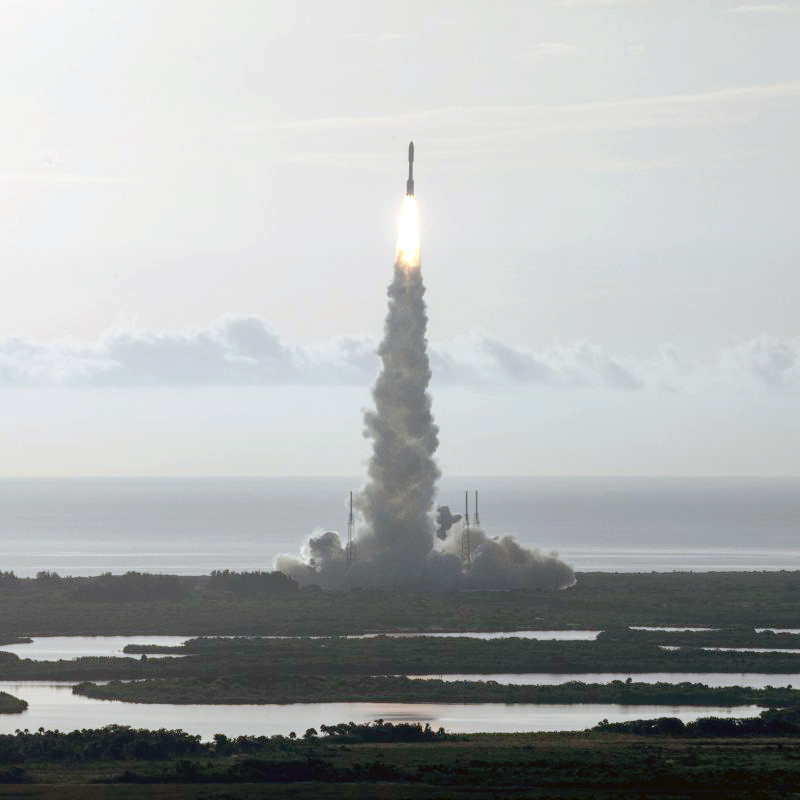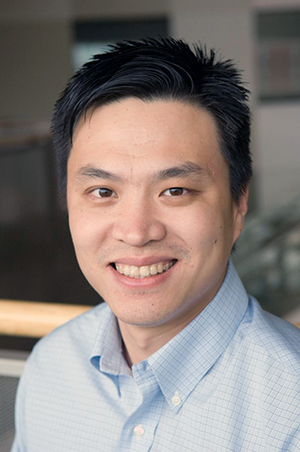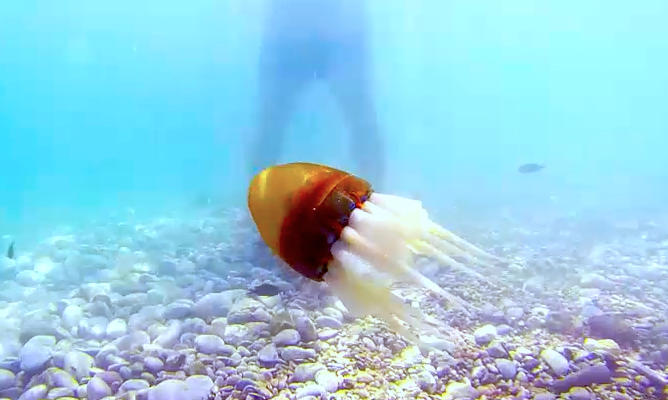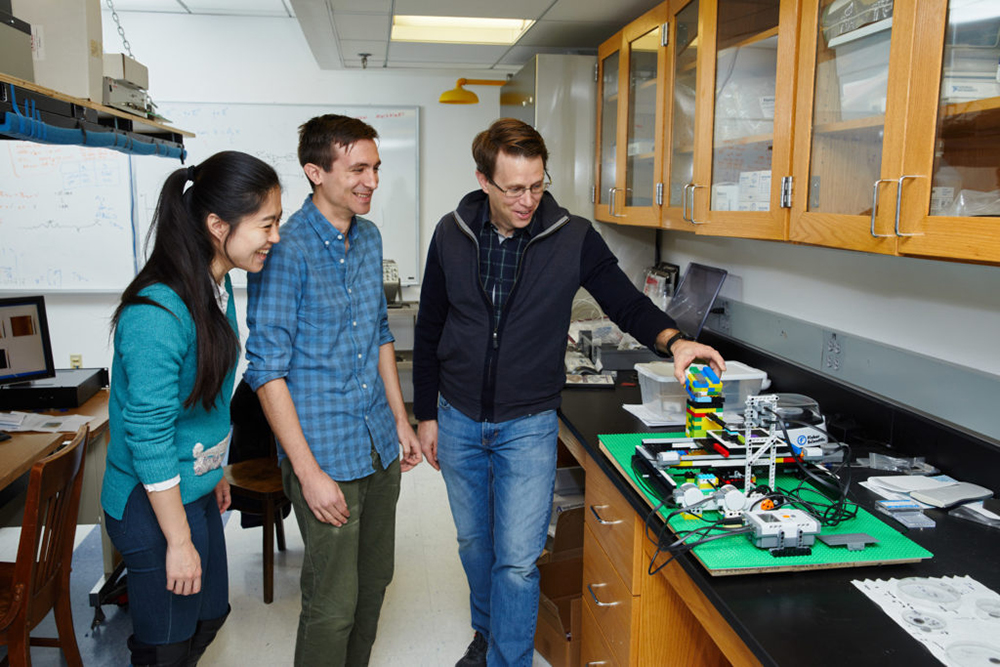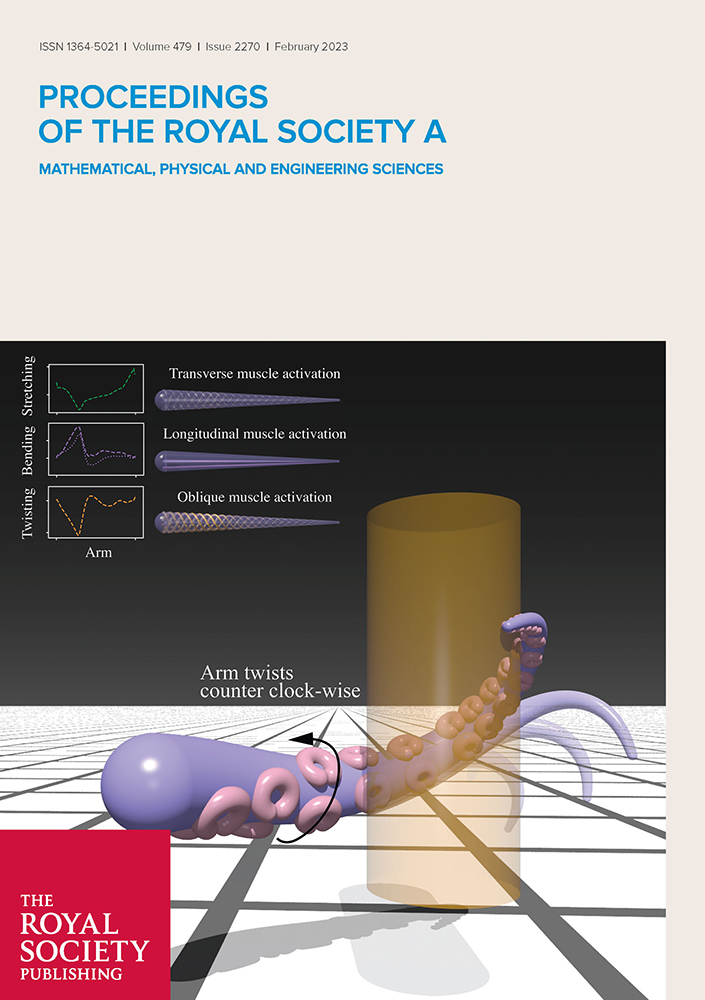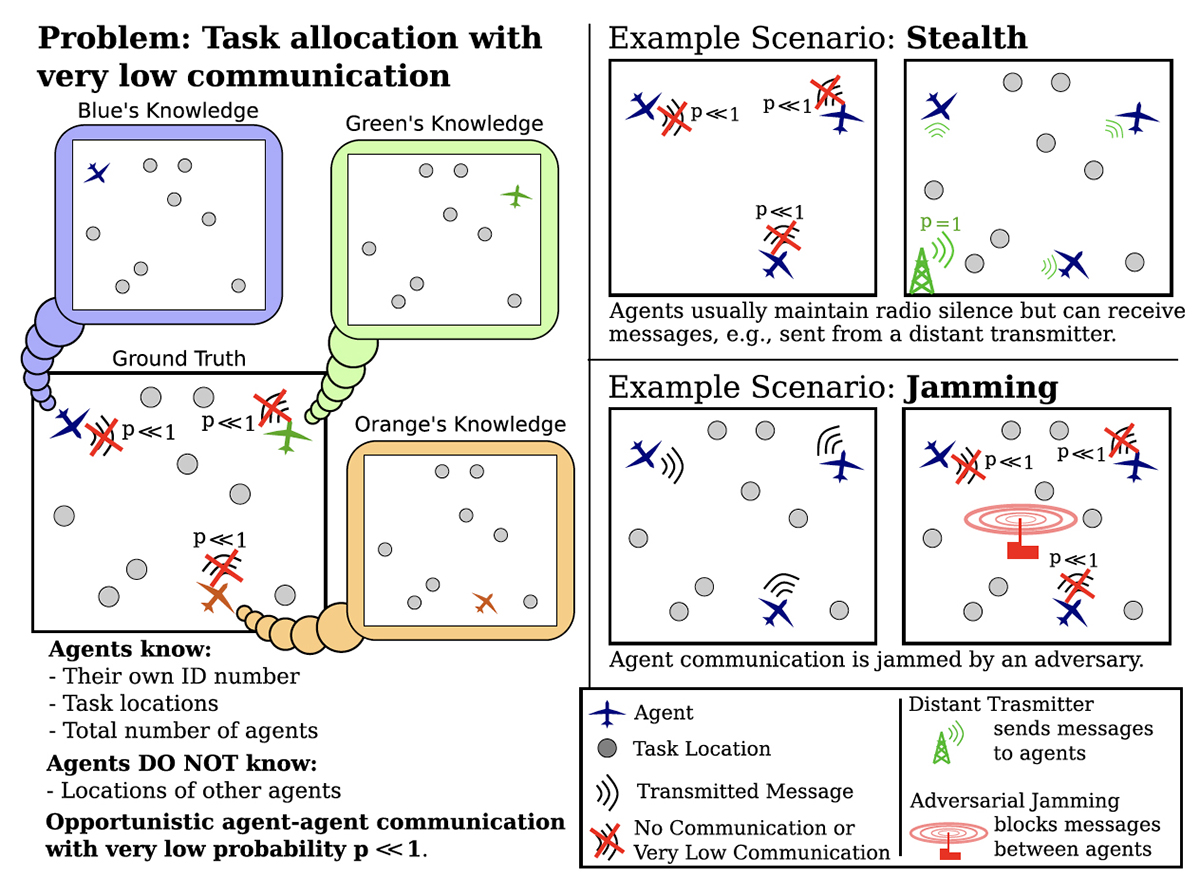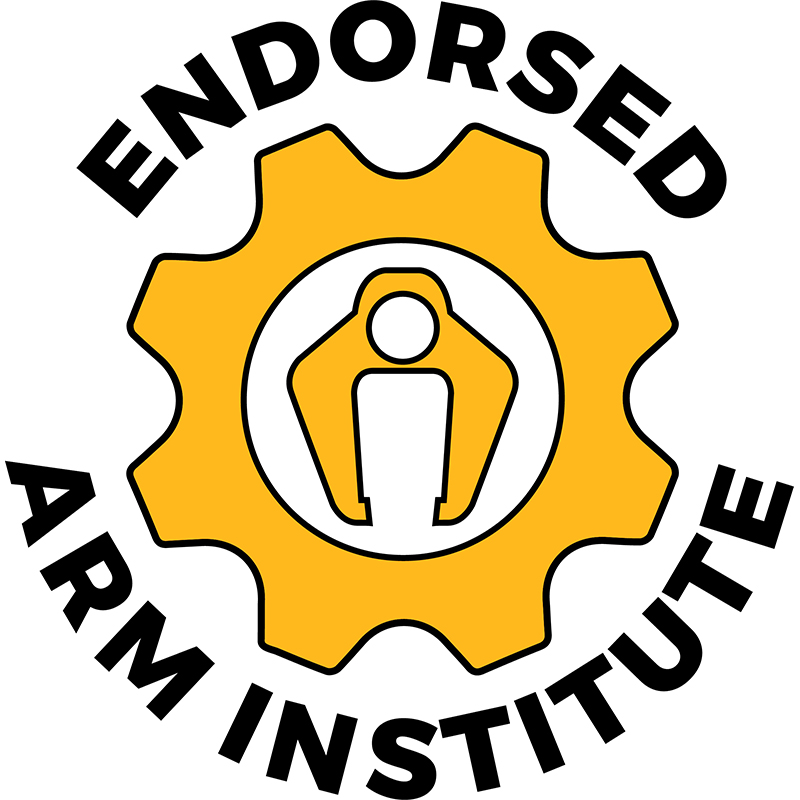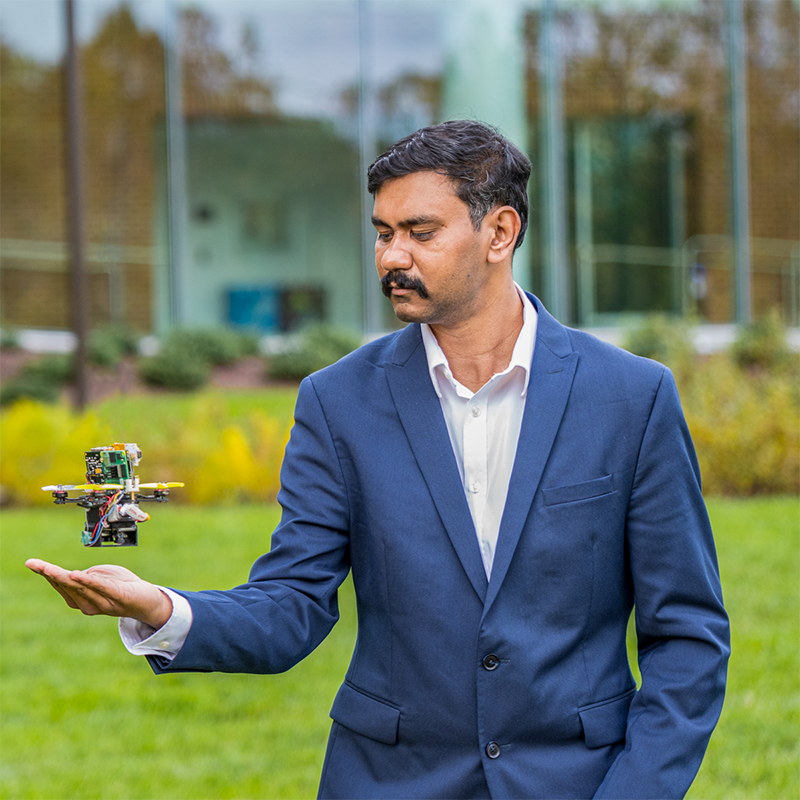News Story
Alumnus Philip Twu's exciting career in space robotics
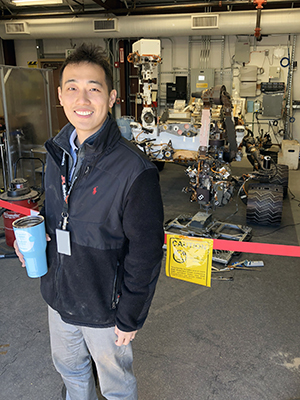
Alumnus Philip Twu (EE, CS 2008 BS) in front of the "Curiosity" Mars Rover testbed at the NASA Jet Propulsion Laboratory in Pasadena, Calif. The "2020" Mars Rover Twu is working on is based on the Curiosity platform.
Developing NASA space robots is a dream job for many engineering students—and exactly the kind of work alumnus Philip Twu (EE, CS BS 2008) has pursued since his graduation. Twu has been able to work on two different NASA space robotics projects: the Parker Solar Probe, which is set to launch this year; and the 2020 Mars Rover, which is in development at this time.
ISR recently caught up with Twu to ask about his research, his scientific interests and how he prepared in college and graduate school for such a cool career.
Was space robotics always what you had in mind for a career? How did this interest develop?
Ever since I was in elementary school I had always dreamed about becoming an explorer. I wanted to discover places that no one has ever been to and uncover the mysteries in this world. Science fiction movies like A.I. Artificial Intelligence, Close Encounters of the Third Kind, and Contact left very deep impressions on me at a young age and directed my curiosity towards space exploration and robotics. However, due to having a limited exposure to science, technology, engineering, and mathematics (STEM) career options while growing up, these interests remained merely just interests that did not seem realistic to pursue nor did I know even how to begin pursuing.
My moment of realization came during my early days as an undergraduate at the University of Maryland where I learned about the Cassini-Huygens mission to Saturn and its moon Titan, as well as about the existence of other alien worlds like Enceladus and Europa where life could possibly exist but the harsh environments meant that any exploration had to be done using robots. Every career and education-related decision I made from that point onwards was done with robotic space exploration as the end goal in the back of my mind.
As a Maryland undergraduate, Twu worked with Professor P. S. Krishnaprasad (ECE/ISR) in the Intelligent Servosystems Laboratory. Dr. Krishnaprasad says, “Philip is a model for many of our systems engineering and robotics aspirants.” Twu also interned at Intelligent Automation, Inc. (IAI) in Rockville, Md., as an undergraduate.
Twu went on the Georgia Institute of Technology for his graduate studies, where he earned a Ph.D. in electrical engineering in 2012, concentrating in systems and controls and digital signal processing.
What sorts of experiences did you have working in the Intelligent Servosystems Lab or during your internship with IAI that helped you define your own research ideas at Georgia Tech and beyond?
Despite always having an interest in robotics, it wasn’t until I joined the Intelligent Servosystems Lab that I actually got to work with robotics for the first time in my life. In the lab, I learned that robotics is not just a straightforward extension of programming or simply hacking together different technologies until you get something that works. Rather, robotics is an interdisciplinary field and can be carefully engineered to have provable behaviors and performance characteristics if approached from a mathematically rigorous perspective. Sitting in on Dr. Krishnaprasad’s lectures to his graduate students exposed me to advanced mathematical concepts that I had never seen before. Up until then I had always considered mathematics to be one of my weaker subjects. However, the experience taught me that in order to move forward with robotics I had to step out of my comfort zone.
During my internship with IAI and while working at the Intelligent Servosystems Lab, I became exposed to the area of multi-robot systems. The general concept was that rather than designing a single highly capable robot to accomplish some given task, an alternate approach can be to design a team of individually less capable robots which work together to collectively accomplish that same task. Such systems have many desirable properties such as re-configurability and robustness but can come at the cost of the complexities associated with decentralized decision making due to the limited sensing and communication capabilities of each robot. Prior to working at the Intelligent Servosystems Lab, I did not plan to pursue a Ph.D. and was even unsure as to whether I wanted to pursue a Master’s degree. Dr. Krishnaprasad encouraged me to believe in my abilities and take the leap to follow my curiosity for knowledge by pursuing a Ph.D.
Tell us a bit about your Ph.D. education at Georgia Tech. What did you do there?
At Georgia Tech I had the privilege of working under Dr. Magnus Egerstedt, now Executive Director of Georgia Tech’s Institute for Robotics and Intelligent Machines. As a member of Dr. Egerstedt’s research group, I continued pursuing my research interests on the decentralized control and coordination of multi-robot systems. I learned about state-of-the-art methods to mathematically model such systems and explored different approaches for controlling them, at times drawing inspiration from interdisciplinary sources such as biology and even marching band formation routines. As part of my research, I investigated the design tradeoffs that robot heterogeneity has on the overall capabilities of a system. My work culminated in two demonstrations of practical applications: 1) a distributed scheduling framework for air traffic merging and spacing that leverages technologies to be introduced as part of the FAA’s NextGen modernization of the national airspace, and 2) a convoy protection scenario involving real unmanned aerial vehicles and unmanned ground vehicles working together to accomplish mission objectives.
Ph.D. in hand, Twu returned to Maryland and joined the Johns Hopkins Applied Physics Laboratory (APL) in Laurel, where he was on the senior professional staff for five years and worked on NASA’s Parker Solar Probe. The car-sized spacecraft, which launches this summer, will be the first-ever mission to “touch” the sun. It will travel directly into the sun's atmosphere—known as the corona—about 4 million miles from its surface, well within the orbit of Mercury and more than seven times closer than any spacecraft has come before. The primary science goals for the mission are to trace how energy and heat move through the solar corona and to explore what accelerates the solar wind as well as solar energetic particles.
Could you talk about your work on the Parker Solar Probe? What part(s) or functions of the probe did you work on?
While at APL, I was on the fault management team for the Parker Solar Probe mission. Spacecraft fault management is a function onboard the spacecraft that detects when something off-nominal is happening to the spacecraft and autonomously initiates an appropriate set of responses to remedy the situation. Depending on the severity of the fault, the response could mean reconfiguring the spacecraft into a reduced operations safe mode in order to preserve its most vital functions until ground operators can intervene and diagnose what happened. Fault management is essential on any spacecraft but is particularly important as well as technically interesting on the Parker Solar Probe mission because of the extreme environments encountered by the spacecraft as it makes flybys of the Sun.
Supporting the mission through part of its integration and testing phase, I gained so much practical experience by witnessing firsthand the process in which individual components and subsystems methodically come together to create a functioning spacecraft. The experience gave me an opportunity to learn about each of the major subsystems of a spacecraft (e.g., communications, power, thermal, guidance navigation and control, etc.) and the complexities of their interactions with one another. The best part of the experience, however, was being able to go to work during testing days and sit just meters away from a spacecraft that will soon be visiting our closest star.
How do you feel about having the solar probe launch this year?
Full of excitement of course! Parker Solar Probe is the first flight mission I ever worked on so it will always have a special place in my heart. Working on the mission, I learned so much and met so many great people all while doing my absolute best to prepare the spacecraft for its upcoming journey. However, there are many others who have been with the mission much longer than me so I can only imagine that their level of excitement far exceeds mine. I see this launch as the culmination of everyone’s hard work and dreams.
In 2017 Twu became a robotic systems engineer at the NASA Jet Propulsion Laboratory (JPL) in Pasadena, Calif., where he is working on the 2020 Mars Rover. This rover will use the same platform as Curiosity, a car-sized, six-wheeled robot currently being readied to explore the Gale Crater on Mars.
In the 2020 mission, NASA scientists hope to determine whether Mars ever had life, characterize Martian climate and geology, and answer questions in advance of potential future human exploration. The 2020 Mars Rover introduces a drill that can collect core samples of the most promising rocks and soils and set them aside in a cache for a future mission to pick up and return to Earth. Also, in anticipation of a future human mission, the rover will test a method for producing oxygen from the Martian atmosphere, identify other resources (such as subsurface water), improve landing techniques, and characterize weather, dust, and other potential environmental conditions that could affect future astronauts living and working on Mars.
What parts or functions of the 2020 Mars Rover are you working on?
I am currently working on systems engineering for rover navigation on the Mars 2020 mission. One of the main science objectives of the mission is for the rover to collect Mars rock and soil samples from regions of astrobiological interest and cache them for a possible future sample return mission. To accomplish this within the allotted timeframe, the Mars 2020 rover will have to traverse faster and navigate across more challenging terrain than any rover before it. The navigation system is comprised of hardware, software, and algorithms, with technological improvements in each domain compared to the previous rover. As a robotics systems engineer, my job is not focused on the engineering of any particular component. Instead, my work requires me to maintain a view of the big picture, address the aspects of engineering that span across multiple components, and ensure that each of the components will be able to work together as a cohesive navigation system for the rover.
What advice would you give to engineering students who are interested in following a similar career path to yours? What sorts of academic experiences do they need? What about internships or postdoctoral work?
When planning for your career after graduation, take the time to understand your audience. If you have a dream job in mind, I strongly urge you to go and look at example job postings as early as possible to figure out exactly what the qualifications are. As a student, you should have an idea of what experiences and skills are valued in the academic community. However, it is important to keep in mind that different communities can value different things. Don’t wait until weeks or months before graduation to do start doing your job research, you may be in for an unpleasant surprise!
Internships at the organization which you want to work at or its peer organizations are extremely valuable. They not only give you better insight into what skills are needed for your dream job, but the directly relevant experience you get and connections you make could give you the edge that you need over others. Finally, don’t be afraid to have to reinvent yourself or develop entirely new skillsets. People rarely work on only one thing their entire careers. Being adaptable and having experience in multiple areas will allow you to develop highly sought-after systems experience.
What’s the most important thing you have learned in your post-Ph.D. life?
Figure out what you truly want in life, make a plan, and go for it! This year marks the 10-year anniversary of when I graduated from the University of Maryland. Trust me, it does not feel like it has been that long at all. We all have a limited time in this world and different people have different success criteria in life. If you are lucky enough to have options, don’t waste the opportunity by making a choice based on the success criteria of others in your life (e.g., acquaintances, co-workers, parents, professors, etc.). The first person that you have to answer to everyday is yourself. When you are truly proud of yourself, it will be easy for others to feel the same way.
Many thanks Philip Twu for taking the time to answer our questions and help our current students. We wish you all the best in your career—and we’ll be thinking of you when the Parker Solar Probe launches this year.
Bonus! If you’d like to know more about NASA robots for Mars, including the upcoming 2020 Mars Rover Twu is working on, mark your calendar for Friday, April 20 at 2 pm. Join us in 2216 JM Patterson Building on campus for a talk by JPL’s Vandi Verma on “NASA Robotic Pioneers on Mars and the Simulators that Drive Them.” This is a seminar in the Lockheed Martin Robotics Seminar Series, hosted by the Maryland Robotics Center.
Published March 30, 2018
